SUBCONTINENT
Growing Value: Indian Art
Amid all the bad news about the economy, one ray of optimism is the steady growth of the market for Indian art, writes Priyanka Bhardwaj.
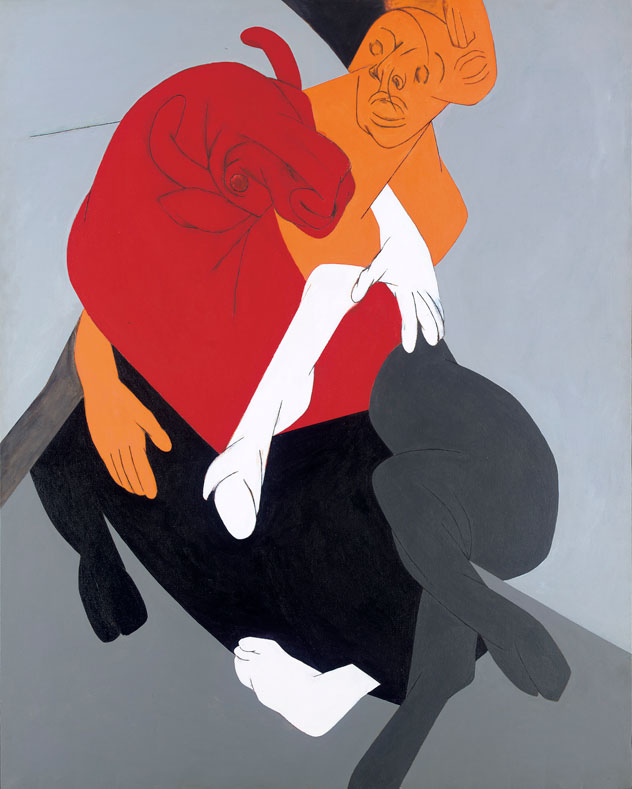
(Above): Mahisasura, Tyeb Mehta.
If there is a sector in India that has managed to beat the recession, credit crunch and economic downturn, it has been Indian art.
The market for Indian art is turning more substantial and varied, with increased global interest from art collectors, investors and auction houses lining up to tap the estimated Rs. 50 billion Indian mart.
A recent indication is the Sotheby’s auction of Asian art works, where a Bharti Kher painting, “Mimic” sold much above pre-sale estimates, while a stainless steel mirror sculpture by Anish Kapoor sold for a record $1.4 million.
While the recession has dented spirits last autumn with many Indian pieces remaining unsold at the Sotheby’s and Christie’s auctions, recent brisk sales of six contemporary, impressionist and modern works have underlined the growing value of Indian art.
“The results are remarkable. I think this goes to show that top-quality works, at the right value, have a very strong market,” according to Maithili Parekh, deputy director at Sotheby’s.
Indeed, observers say that the India art market is growing at a good pace of over 40 percent presently, compared to less than 20 percent 7-8 years back. Apart from Indian patrons, interest from international buyers with non-India roots is also up.
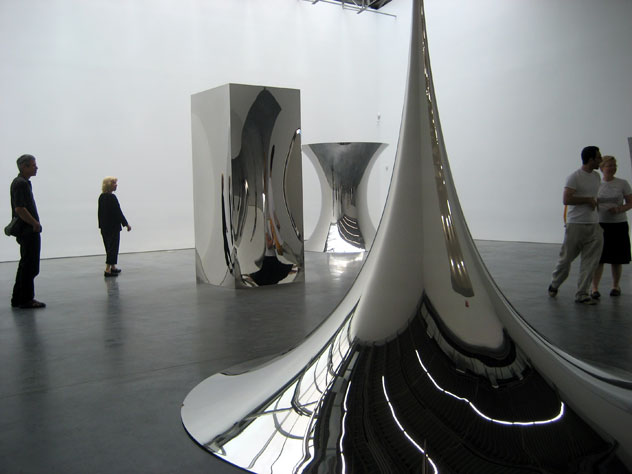
(Above): Reflection, Anish Kapoor.
Fund managers and gallery owners in Mumbai confirm that investors (perhaps hurt by the crash in the real estate and stock markets over the last year) have diverted their money into art.
This has inflated values by 30-60 percent, giving rise to a new breed of art investors as compared to art connoisseurs, who identify art works as brands to trade.
The attractiveness of the Indian works is enhanced by lower pre-sale estimates, shrinking of catalogue size and recalibration of prices of art pieces.
Indeed, from modern artists such as M.F. Husain, Francis Newton Souza and S.H. Raza, to contemporary ones such as Subodh Gupta, and upcoming ones, such as Chitra Ganesh, Indian artists are making a global splash and making big money too.
Saffronart.com, in its Autumn Online Auction in 2007, facilitated the $1.5 million sale of a painting by Francis Newton Souza.
A New York based Indian hedge-fund manager paid $1.6 million for Tyeb Mehta’s paintings titled “Mahisasura,” a Hindu buffalo demon destroyed by Hindu Goddess Durga.
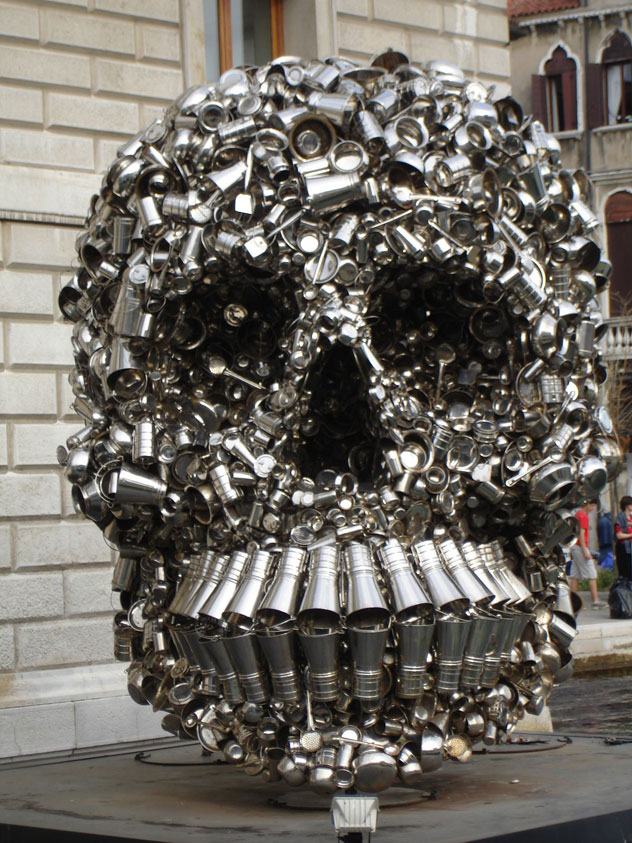
(Above): A Very Hungry God, Subodh Gupta.
An upcoming contemporary artist, Isha Saraf, who spent 10 years in New York, said: “The new art galleries in New York like ‘Bodhi Art’ are providing an apt platform to Indian contemporary art, full of vibrant colors, mixed emotions, gods, flowers and landscapes as compared to the Western art that has a more emotive feel.”
Elaborating on the interest in Indian art, she said, “Indian art is breaking boundaries in terms of imagination, horizons, depiction and also becoming commercial.”
Shekhar, an art collector and owner of Creativity Art Gallery, New Delhi, says, “The global financial meltdown has impacted the pricing of art work already bracketed in the bigger league, but the mass body of art work (including India) is only gaining in awareness and thus witnessing an appreciation in prices.”
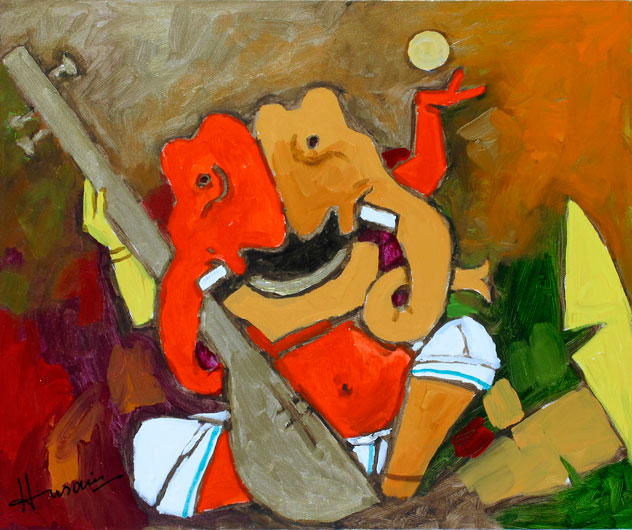
(Above): Nadaswaram, M.F. Husain.
Saffronart director Dinesh Vazirani says, “Since 2000, the foreign-interest has risen and buyers comprise NRIs (Non Resident Indians) and foreign individuals, auction houses, collectors and investors.”
Private banks are helping patrons build portfolios of art works, gallery auctions and direct sales, in return for a fee.
Indeed, organized forums are betting on Indian artists and their works lately. The international interest has spurred changes such as the Devi Art Foundation, India’s first contemporary art museum in early 2008.
Major exhibitions have been planned this year at London’s Serpentine Gallery, Japan’s Mori Art Museum and the prestigious Arco Contemporary Art Fair in Madrid.
The Arco Contemporary Art Fair in Spain will provide pointers to the benchmarking of Indian art collections vis a vis global works.
On the cards is the release of a movie called “Rang Rasiya,” based on the life of Raja Ravi Verma, a 19th century visionary painter, who contributed to making Indian art part of popular culture.
Art arbiter Charles Saatchi began collecting Indian art last summer and plans to put on an exhibition titled “The Empire Strikes Back: Indian Art Today,” this year.
Neville Tuli, founder and CEO of Osian’s Connoisseurs of Art, a premier art gallery of India, stressed that international collectors and museums have a fairly developed interest in classical art and antiquities, but not in Indian modern and contemporary art, which is evoking fresh interest.
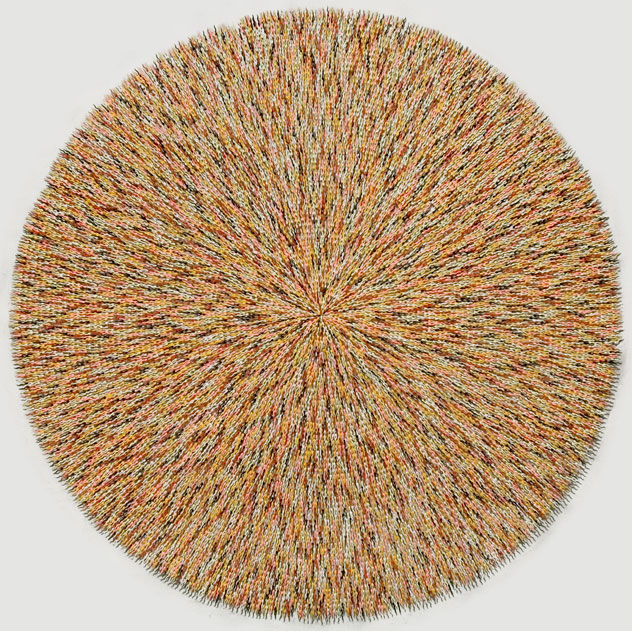
(Above): Spit, Bharti Kher.
Peter Nagy, a New Yorker who arrived in India in 1992, and within five years set up Nature Morte, one of the best-known art galleries in New Delhi has been quoted to say: “In terms of the international scene the interest in India is still nascent, yet my gallery is swamped with inquiries from curators, private collectors, galleries and foreign journalists.”
Nagy opened a gallery in Kolkata last year in association with New York’s Bose Pacia Gallery, and a branch is due to open in Berlin, to showcase both Indian and non-Indian contemporary art.
“With the economy opening up in the Nineties, Indian culture has become more relevant to the rest of the world,’’ says Nagy. “It’s influencing music and fashion — Punjabi folk music is mixed with gangster rap and the hip restaurants in New York are Indian.”
Yet, issues related to paucity of state funding and support for newer artists, absence of critical enquiry or appreciation of art, patronage, preservation efforts, scientific restoration of works, expert marketing strategies, qualified curators, support staff and informed docents, need to be addressed.
Censorship and intolerance by right wing fanatics have been a discouraging trend.
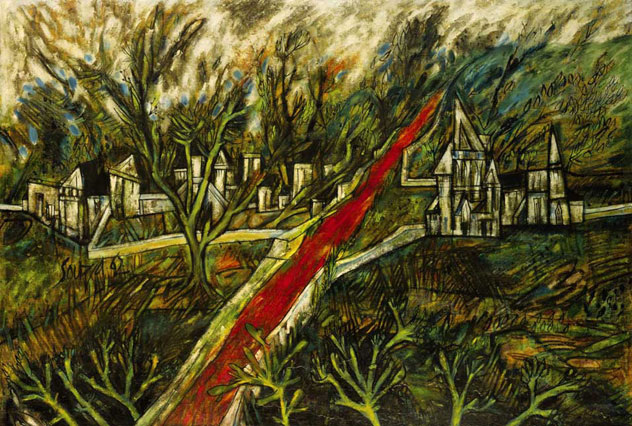
(Above): The Red Road, Francis Newton Souza.
The nonagenarian M.F. Husain, in his 90s, stays in self imposed exile in Dubai due to threats from Hindu groups enraged by his paintings of nude gods and goddesses.
In the past decade of relative non-recognition, though, there have been positive developments in Indian art: experimentation, newer issues, original thinking, international idioms espousing Indian ethos, expressive styles, modalities and infusion — all have brought a unique global interest to the Indian body of art.
Yet an important question remains: How much of this is froth, and how much real? Is the increased interest and consequent skyrocketing price of Indian art reflective merely of nationalistic pride for the Indian nouveaux riches, whether in India or abroad, and a passing fancy for non-Indian global clientele caught up in a transient fad where all things Indian are sexy? Or is there some genuine aesthetic interest developing on Indian art? The recent global economic downturn could not present a sterner test, and if Indian art has crossed the initial hurdle with flying colors, the jury is till out on its longer term prospects.
|